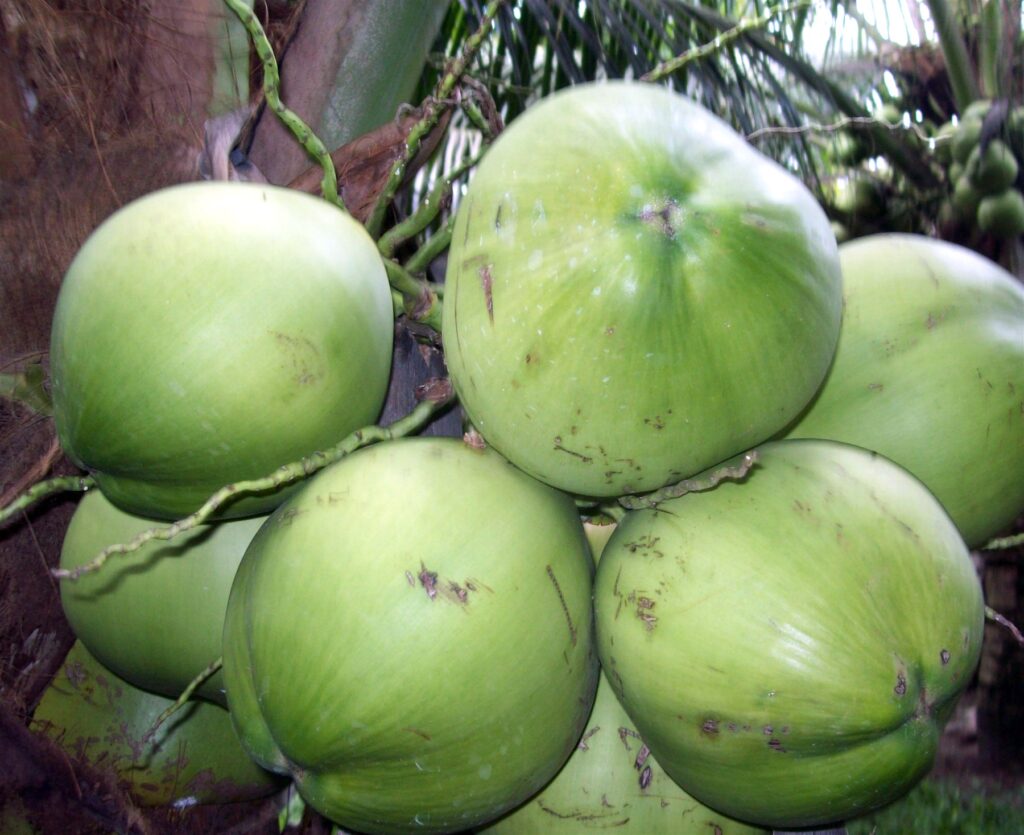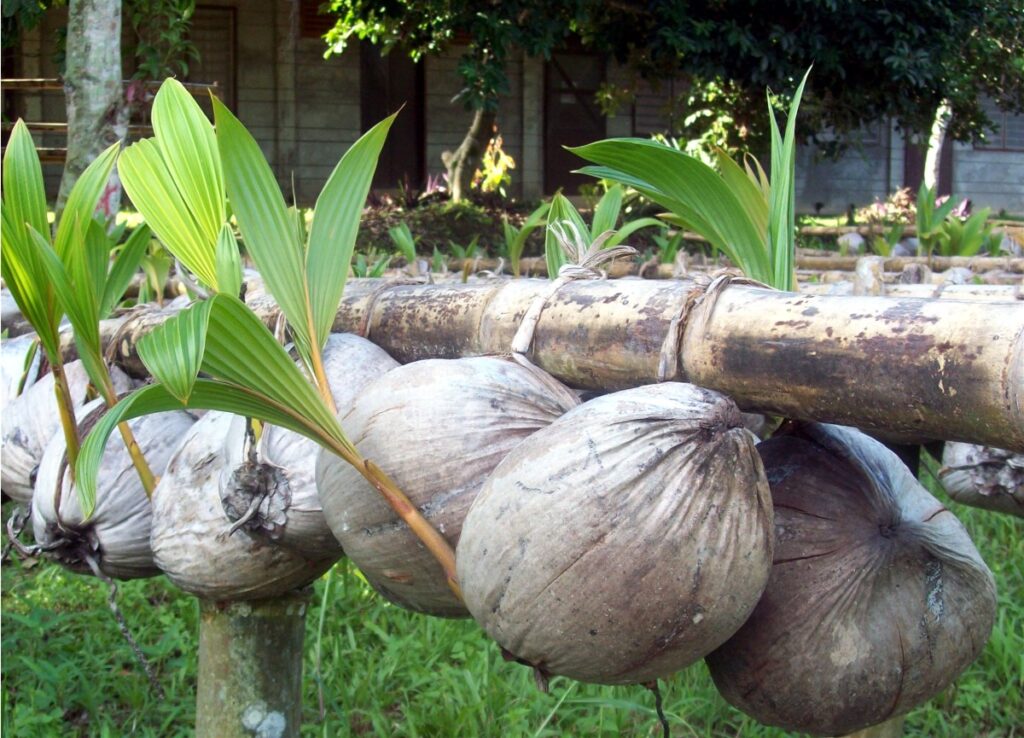Text and Photos by Henrylito D. Tacio
Although not a native of the Philippines, coconut is considered as God’s gift to Filipinos. As one historian wrote: “A man sleeps in the shade of the tree. He is awakened when a nut falls, drinks the water, and eats some of the meat. He then feeds the rest of the meat to the chickens, which produce eggs, milk, and meat. The leaves provide thatch for the roof and walls of his coconut hut, and are also woven into hats, baskets, and mats.”
The Philippines is the world’s second largest producer of coconut products, after Indonesia. But the Philippines is the top exporter of coconut products (about 64% of the world’s copra and coconut oil comes from the Philippines). About 25% of cultivated land is planted to coconut trees, and it is estimated that between 25% and 33% of the population is partly dependent on coconuts for their livelihood.
Copra or dried coconut meat is the main product of coconuts. It has a high oil content, as much as 64%. Coconut oil, which is the most readily digested among all fats of general use in the entire world, provides about 9,500 calories of energy per kilo. Its chief competitors are soya bean oil, palm oil, and palm kernel oil.
Unknown to many, coconut oil is used as a basic ingredient in some cosmetic soap products. Coconut oil is also used as a basic ingredient to make toothpaste for sensitive teeth. In addition, coconut oil can also be applied to skin to treat minor irritations like insect bites and sunburn.
In the Philippines and other parts of Asia, coconut oil is used in cooking. But its use is being discouraged in Western countries like the United States as it reportedly contains highly saturated fats, which is bad for the heart.
“In the United States, they do not sub-classify fats,” says Yvonne T. B. Agustin, of the United Coconut Association of the Philippines. “Saturated fat is saturated, period. Unlike with polyunsaturated, we have Omega 3, Omega 6, and Omega 9. Americans do not classify saturated fats as either short-chain, medium-chain, or long-chain saturated. They only know one kind of saturated fat and that’s animal fat.”
What those people don’t know is that the type of fat in coconut oil is a medium-chain saturated fat that is easily metabolized into energy. “These fatty acids are different from those commonly found in other food sources and are burned almost immediately for energy production, and so that they are not converted into body fat or cholesterol and do not affect blood cholesterol levels,” said Dr. Bruce Fife, a nutritionist and naturopathic physician who wrote The Healing Miracles of Coconut Oil.
Now, there’s another use of coconut oil. Being rich in medium-chain fatty acids, coconut oil was found to be an effective dietary supplement to promote the growth of saline-tolerant tilapia.
Saline-tolerant tilapias are strains originally developed by Filipino researchers intended for the expansion of tilapia production in brackish water and saltwater environments and to prevent mass mortalities due to saltwater intrusions into the rivers due to rising seawater levels in tilapia-producing areas.
The use of coconut oil as dietary supplement for tilapia was discovered through the project, “Medium Chain Fatty Acids and Mannose Polysaccharide from Coconut as Dietary Supplement to promote growth and improve health of cultured saline-tolerant strain of Oreochromis niloticus.”
The said study was funded by the Laguna-based Philippine Council for Agriculture, Aquatic and Natural Resources Research and Development (PCAARRD) of the Department of Science and Technology (DOST). The project intended to address the high cost of tilapia feeds.
As a result of the study, the use of expensive and imported soybean feed oil used as energy source in tilapia feeds was decreased.
“The project findings showed that coconut dietary supplement can eliminate completely the use of dietary soybean oil and improve growth without compromising the health and survival of saline-tolerant tilapia,” wrote Dr. Carmelo S. del Castillo and Rizza B. Ramoran of the Science and Technology Media Service.
According to the study, the growth promoting effect of the medium-chain fatty acids is attributed to significant enhancement of Insulin-like Growth Factor (IGF), a growth hormone inducer that promotes growth hormone secretion and increases fish growth.
Coconut oil, the study said, contains about 50 percent medium-chain fatty acids that are beneficial in promoting growth and improving tilapia health.
“Coconut oil supplementation in the tilapia diet has also improved fatty-acid composition of the tilapia flesh,” Del Castillo and Ramoran wrote.
Meanwhile, through the Coconut Hybridization Program (CHP), the genetic potential and yield performance of four newly developed single-cross coconut hybrids are being evaluated through a project funded by the PCAARRD. The CHP is a vital component of PCAARRD’s Industry Strategic Program for coconut program.
Determining coconut hybrids’ genetic potential and yield performance is crucial in understanding their ability to meet the market demands with the growing need for high-value coconut products, said project leader Gilbert M. Eslit of Zamboanga Research Center (ZRC) of the Philippine Coconut Authority.
The ZRC developed the four single-cross hybrids with unique and special traits, which utilized Tutupaen Tall (TPNT) as source of pollen, and Sanchez-Mira Tall (SCHT), Markham Valley Tall (MVT), Malayan Red Dwarf (MRD), and Galas Green Dwarf (GALD) as mother palms. These hybrids are MRD x TPNT, GALD x TPNT, SCHT x TPNT, and MVT x TPNT.
The hybrids – of which 120 palms per hybrid are maintained by the five-year project at the field genebank of ZRC – will be further characterized and evaluated in terms of shell thickness, seed nut size, water, oil qualities, coco sap and sugar yield, prolificacy, and general combining ability.
In its first year of implementation, the project team conducted preliminary screening of the extracted deoxyribonucleic acid (DNA) samples from 1,632 tissue samples collected from hybrids and parental palms using simple sequence repeat (SSR) markers to validate the legitimacy of the hybrids. Confirmation of unique alleles among these hybrids is underway.
Field assessment also showed that hybrids have an average palm girth of 80–100 centimeters and can grow to an average height of 600–700 centimeters.
Initial reproductive data also reveal that some hybrid palms, such as MRD x TPNT, started to bloom and produce fruits at 34 months from field planting, which is earlier than anticipated. MRD pairs well with local and foreign tall varieties, while TPNT has a thick shell. With this, the project team expects a high yield of copra and oil, good fatty acids, a thick shell, and an excellent toddy from the MRD x TPNT hybrid.
In the following years, the project will conduct ecological testing to assess the hybrids’ adaptability in different locations.
Due to persistent encounters with coconut scale insect (CSI) infestations at the farm sites, Science and Technology (S&T) Consultant Violeta N. Villegas suggested incorporating the team’s pest management strategies in their reports as hybrid palms were still able to demonstrate robust growth and development consistently.
CSIs are invasive pests that feed on the sap of coconut palms, resulting in slowed development, leaf yellowing, and in severe cases, the palms’ death.
Another PCAARRD-funded continuing project being done by ZRC sees the potential of developing multi-parent coconut hybrids as an effective strategy to combat insect pests and diseases, enhance tolerance against drought and strong winds, and increase nut and oil yield.
Multi-parent populations are hybrids produced by crossing different multiple varieties, explained project leader Gerardo B. Baylon. Many of these have been successfully developed globally in other crops such as oil palm, corn, cowpea, and rice to improve resistance and yield.
The project team highlighted that this initiative is a significant stride in advancing coconut breeding research in the Philippines. While the country has previously explored double or four-way cross hybrids using carefully selected tall and dwarf coconut varieties, no program has gone beyond the second generation.
Using hand pollination hybridization technique, the project will cross outstanding dwarf varieties as mother palms to composite populations as pollen sources to develop six multiparent hybrids. Comprehensive crossing plans for the six multiparent hybrids were developed for daily monitoring.
Hand pollination hybridization techniques involve emasculation of the male flowers, bagging, and then pollinating the receptive female flowers using pollen from the identified source. The isolation bag is usually removed on the sixth day after pollination when the female flower turns brownish-black.
During the recent project review, Science and Technology Consultant Violeta N. Villegas recommended specifying in detail the biotic (examples: coconut scale insects and bud rot) and abiotic (examples: strong winds and drought) stress parameters that the project aims to evaluate in the multi-parent coconut populations.
Aside from developing coconut hybrids, the project also aims to profile the fatty acids of eight composite varieties found at the ZRC to support virgin coconut oil (VCO) production in the country. Fatty acid data gathering of the said varieties for the wet season is already completed, while the preparation for data gathering during the dry season is underway.
Moreover, two plant breeders received training on coconut hybridization techniques, pollen extraction, and marker-assisted breeding. Ten project staff members were also trained in coconut field establishment and good agricultural practices.
In response to the increasing demand for coconut meat and water from various industries, an ongoing project aims to profile and recommend more coconut hybrids, along with local and foreign varieties, with outstanding qualities.
In the Philippines, coconut genetic resources remain largely untapped due to the lack of comprehensive data on their physicochemical properties, which refers to the physical and chemical characteristics of a substance and its interaction with other substances.
Thus, another ZRC-led study targets to produce the physicochemical profiles of coconut waters and meats of 26 coconut hybrids and 55 local and foreign coconut varieties conserved at the Center’s genebank.
Project leader Joel Gerone B. Larupay reported that for its first year of implementation, the project generated the physicochemical profiles of coconut meat, water, and oil of 15 PCA-recommended hybrids, 5 dwarf, and 8 tall varieties.
Initial findings revealed that hybrids, compared with traditional varieties, have higher values of total soluble solids, mineral contents, meat firmness, and water volume.
Further, traditional and hybrid varieties vary slightly in fat composition, while both contain over 50 percent medium-chain triglycerides and a high amount of lauric acid in their coconut oils, giving them distinct flavors and textures.
The information gathered from the study is seen to be useful for farmers and manufacturers to ensure quality, consistency, and marketability of their products, Larupay said. – ###



